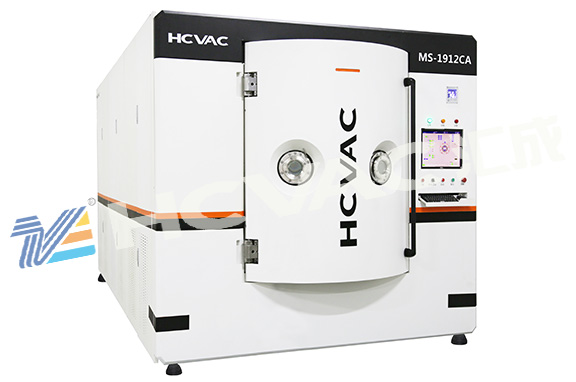During the operation of the pvd coating machine, a vacuum pump must be configured so that the workpiece can be coated under the required vacuum conditions. Vacuum degree is an important parameter in the vacuum coating process. The coating layers on the workpiece are different, and the coating processes used are different, so the requirements for vacuum plating are also different. Below, the editor of Huicheng Vacuum will introduce to you the vacuum pumps that need to be configured during the coating process of the pvd coating machine.

1. A device that generates, improves or maintains vacuum. Vacuum plating is divided into low vacuum, medium vacuum and high vacuum. The types of vacuum pumps used in low vacuum, medium vacuum and high vacuum are different. For example, low vacuum generally only has mechanical ones. Pumps and rotary vane pumps, slide valve pumps and Roots pumps are used for medium vacuum, and diffusion pumps and molecular pumps are used for high vacuum. Then depending on the workpiece and the coating material being plated, the coating process used is different, so the vacuum pump models used in each stage of vacuum plating are different, and the number of vacuum pumps is also different.
In daily life, we often say that low vacuum refers to low vacuum 10E5~10E2 Pa, medium vacuum 10E2~10E-1 Pa, high vacuum 10E-1~10E-5 Pa, and ultra-high vacuum <10E-5 Pa.
2. A.
pvd coating machine: evaporation coating machine, magnetron sputtering coating machine, ion coating machine and plasma chemical deposition device, etc.
3. Vacuum measuring instrument: an instrument that measures gas and vapor pressure below one atmosphere.
A. Low vacuum gauge (measuring range 105--102Pa).
B. Medium vacuum gauge (measuring range l02 to l0-1Pa)
C. High vacuum gauge (measuring range l0-1 to 10-5Pa).
D. Ultra-high vacuum gauge (measuring range < 10-5Pa).
4. Vacuum leak detector - an instrument that detects the location or leak rate of leaks in vacuum systems or components. Including high-frequency spark leak detectors, halogen leak detectors and helium mass spectrometer leak detectors, etc.
5. Vacuum valve - In the vacuum system, it is a component used to adjust the flow, cut off or connect the pipeline. Including gate valves, flapper valves, solenoid valves, solenoid belt release valves, diaphragm valves and regulating valves, etc.
In order to better understand and choose the vacuum pump of the vacuum coating machine, we must pay attention to the following points:
1. Does the vibration generated by the vacuum pump during operation have any impact on the process and the environment? If the process does not support it, a vibration-free pump should be selected or a series of anti-vibration measures should be taken.
2. Understand the composition of the pumped gas, whether there are particles of dust in the gas, whether it is corrosive, etc. When choosing a vacuum pump, you need to know the gas composition, and choose a corresponding pump for the gas being pumped. If the gas contains vapor, particles and corrosive gases, you need to consider installing auxiliary equipment on the air inlet pipeline of the pump. 3. Under its working pressure, the vacuum pump can discharge all the gas generated during the vacuum equipment process.
4. Correctly combine the vacuum pump. Sometimes one type of pump cannot meet the air pumping requirements. Since vacuum pumps have selective air pumping, several pump combinations are needed to complement each other to meet the air pumping requirements. If the titanium sublimation pump has a high pumping speed for hydrogen, but cannot pump helium, and the tripole sputtering ion pump (or the diode asymmetric cathode sputtering ion pump) has a certain pumping speed for argon, the two combinations up, the vacuum device will obtain the corresponding vacuum degree.
5. Requirements for oil pollution in vacuum equipment. If the equipment clearly requires oil-free, various oil-free pumps should be used, such as: water ring pumps, molecular sieve adsorption pumps, sputtering ion pumps, cryogenic pumps, etc. If the requirements are not strict, you can choose oil pumps with some oil pollution prevention. measures.
6. Correctly select the working point of the vacuum pump. Each pump has a certain operating pressure range. Therefore, the working point of the pump should be selected within this range, and it should not be allowed to work under 25~30mmHg for a long time.
7. What is the impact of the oil vapor discharged from the vacuum pump on the environment? If the environment does not allow pollution, you can choose an oil-free vacuum pump or discharge the oil vapor outdoors.
8. The working pressure of the vacuum pump should meet the ultimate vacuum and working pressure requirements of the vacuum equipment. For example: a certain vacuum drying process requires a working vacuum degree of 10mmHg. The ultimate vacuum degree of the selected vacuum pump must be at least 2mmHg, and preferably 1mmHg. Usually, the ultimate vacuum degree of the pump is selected to be half to one order of magnitude higher than the working vacuum degree of the vacuum equipment.
9. Finally, consider the initial installation price, operation and maintenance costs of the vacuum pump, and choose a vacuum pump with a high cost-effectiveness based on the actual situation.



